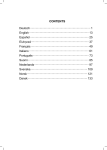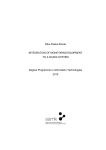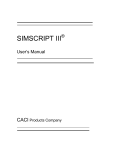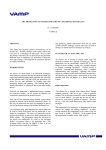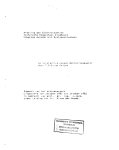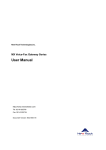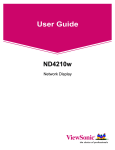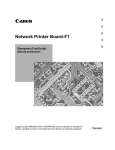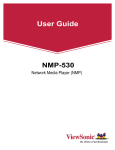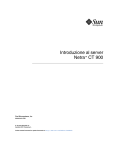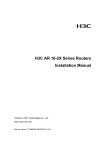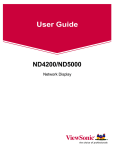Download VAASAN AMMATTIKORKEAKOULU
Transcript
Hidajete Isa
WEB BASED GUI MANAGEMENT FOR
FLEXINT22 SHDSL.BIS MODEM
Technology and communication
2011
FOREWORD
First of all I want to thank my family, especially my mother who has supported
me from the beginning, her encouragement is what kept me motivated and moved
forward. I also want to thank my friends who supported me.
Secondly I want to thank Pekka Lappalainen, R&D Manager, for giving me this
opportunity to do the bachelor thesis at their department. I also would like to express my sincere gratitude to my instructor Tommi Lundell, SW Team leader, for
his great help and guidance during the entire project. A big thank you goes to all
the co-workers that helped with this project.
Finally, I wish to thank my supervisor Antti Virtanen, senior lecturer, for the
valuable advice and support he has given me in the writing of this report.
15.2.2011 Helsinki
Hidajete Isa
VAASAN AMMATTIKORKEAKOULU
UNIVERSITY OF APPLIED SCIENCES
Tietotekniikan koulutusohjelma
ABSTRACT
Author
Title
Year
Language
Pages
Supervisor(s)
Instructor
Hidajete Isa
Web Based GUI Management for FlexiNT22 SHDSL.bis
Modem
2011
English
51
Antti Virtanen
Tommi Lundell, SW Team Leader
The purpose of this thesis was to design and implement a prototype of a web
based GUI management for FlexiNT22 SHDSL.bis modem at Nokia Siemens
Networks BBA NBMS division.
Web based GUI management gives an administrator the ability to configure and
monitor FlexiNT22 over the Internet using a web browser. The most direct way to
accomplish this is to embed a web server (Embedded web Server) into the modem, and use that server to provide web-based management user interface constructed using HTML language.
The project involved familiarizing with the operations and characteristics of FlexiNT, searching for an appropriate web server, examining the features and the
compatibility with the software, evaluation and implementing a demo version.
The evaluation consists mainly of three parts: Surveying web servers and further
choosing the most suitable web servers for the evaluation. In the third place, we
were concerned with defining criteria of the embedded web server features for
evaluation.
The project was carried out using KLone embedded web server, which is open
source software. The study describes how to program HTML pages in C language
and how to implement web pages. As result pages could be embedded into a single executable binary file that contained KLone’s HTTP/S server.
Keywords
Embedded web server, web-based gui management, shdsl
modem, html, C language
VAASAN AMMATTIKORKEAKOULU
Tietotekniikan koulutusohjelma
TIIVISTELMÄ
Tekijä
Opinnäytetyön nimi
Vuosi
Kieli
Sivumäärä
Ohjaaja
Valvoja
Hidajete Isa
FlexiNT22 SHDSL.bis modeemin web-hallintasovellus
2010
Englanti
51
Antti Virtanen
Tommi Lundell, SW Team Leader
Tämän opinnäytetyön tavoitteena oli suunnitella ja toteuttaa graafinen webpohjainen käyttöliittymä prototyyppi FlexiNT22 SHDSL.bis päätelaitteeseen
Nokia Siemens Networksin NBMS (Narrowband Multiservic) osastolle.
Web-hallintasovellus antaa järjestelmänvalvojalle mahdollisuuden määrittää ja
valvoa
FlexiNT22
modeemia
internetin
kautta
käyttäen
webselainta.Toteuttaakseen tämän tarvitaan sulautettu Web-palvelin joka upotetaan
modeemin sisään, ja käyttäen tätä palvelinta luodaan web-hallintasovellus HTMLkielellä.
Projekti jakautuu kahteen osaan: tutkiminen ja implementaatio. Tutkimukseen
kuului perehtyminen FlexiNT:n toimintaan ja ominaisuuksiin, sopivan webpalvelimen etsiminen ja sen ominaisuuksien tutkiminen ja soveltuvuus
ohjelmiston kanssa. Sulautettu web-palvelin on ideaali tähän projektiin.
Valintamenetelmiin kuului valita kolme sopivinta palvelinta ja tutkia niiden
ominaisuudet.
Implementaatioon kuului suunnitella ja toteuttaa toimiva web-hallintasovellus
runko.
Työ toteutettiin käyttäen KLonen web-palvelinta, joka on avoimen lähdekoodin
ohjelmisto. Tässä työssä kuvataan, miten ohjelmoidaan HTML-sivuja käyttäen Ckieltä ja miten ne toteutetaan. Lopputuloksena web sivut voidaan upottaa yhteen
binääri ohjelmatiedostoon, joka sisältää KLone HTTP/S-palvelimen.
Asiasanat
sulautettu web-palvelin, web-pohjainen käyttöliittymä,
shdsl modeemi, html, c-kieli
5
SYMBOLS AND ABBREVIATIONS
ASCII
American Standard Code For Information Interchange
ASP
Active Server Pages
ATM
Asynchronous Transfer Mode
BBA
Broadband Access
BSS
Business Support Systems
CGI
Common Gateway Interface
CLI
Command Line Interface
COSI
Common Operating System Interface
CPU
Central Processing Unit
CSS
Cascading Style Sheets
CVS
Concurrent Versions System
DAA
Digest Access Authentication
DSLAM
Digital Subscriber Line Access Multiplexer
EFM
Ethernet in the First Mile
EFMC
EFM over Copper
EOC
Engineering Order Channel
EWS
Embedded Web Server
FE
Fast Ethernet
GE
Gigabit Ethernet
6
GPL
General Public License
HTML
HyperText Markup Language
HTTP
HyperText Transfer Protocol
IEEE
Institute of Electrical and Electronics Engineers
IETF
Internet Engineering Task Force
IIS
Internet Information Services
IP
Internet Protocol
ISP
Internet Service Providers
LMI
Local Management Interface
MAC
Media Access Control
MIB
Management Information Base
MII
Media Independent Interface
MIME
Multipurpose Internet Mail Extension
NBMS
Narrowband Multiservice
NMS
Network Management System
NVT
Network Virtual Terminal
OAM
Operation Administration and Maintenance
OS
Operating System
OSE
Operating System Embedded
OBS
Operations and Business Software
7
OSS
Operation Support Systems
PAM
Pulse Amplitude Modulation
PMA
Physical Medium Attachment
PMD
Physical Medium Dependent
PWE
Pseudo Wire Emulation
RAM
Random Access Memory
RCS
Revision Control System
ROM
Read Only Memory
RSTP
Rapid Spanning Tree Protocol
RTOS
Real Time Operating System
SHDSL
Single-pair High speed Digital Subscriber Line
SNMP
Simple Network Management Protocol
SSH
Secure Shell
SSI
Server Side Includes
SSL
Secure Socket Layer
STP
Spanning Tree Protocol
TC
Transmission Convergence
TCP
Transmission Control Protocol
TDM
Time Division Multiplexing
TLS
Transport Layer Security
8
URL
Universal Resource Locator
UTP
Unshielded Twisted Pair
VCS
Version Control System
VFS
Virtual File System
VLAN
Virtual Local Area Network
XML
Extensible Markup Language
9
CONTENTS
FOREWORD
ABSTRACT
TIIVISTELMÄ
SYMBOLS AND ABBREVIATIONS
1
INTRODUCTION .......................................................................................... 12
1.1 Project description .................................................................................. 12
1.2 Company Background ............................................................................ 13
2
FLEXINT22 SHDSL.bis MODEM ................................................................ 14
2.1 Overview ................................................................................................. 14
2.2 General Features ..................................................................................... 14
2.3 Development Environment ..................................................................... 16
2.4 Software Platform ................................................................................... 16
2.5 Operating System .................................................................................... 17
2.6 TDM Interface ........................................................................................ 18
2.7 Fast Ethernet Interface ............................................................................ 18
2.8 SHDSL Interface ..................................................................................... 19
2.9 SNMP Protocol ....................................................................................... 19
2.10 Telnet Protocol ........................................................................................ 20
2.10.1 The Network Virtual Terminal (NVT) ........................................ 20
2.10.2 Options and Option Negotiation ................................................. 21
2.11 EFM – Ethernet in the First Mile ............................................................ 21
2.12 ATM – Asynchronous Transfer Mode .................................................... 22
2.13 General Web Server ................................................................................ 22
2.14 Embedded Web Server ........................................................................... 23
2.15 HTTP – HyperText Transfer Protocol .................................................... 24
3
WEB SERVER SELECTION ........................................................................ 27
3.1 Requirements for Embedded Web Servers ............................................. 27
3.2 Embedded Web Server Solution Survey................................................. 27
10
3.3 The most Appropriate Solution............................................................... 29
3.3.1 KLone.......................................................................................... 29
3.3.2 Nichestack HTTPServer.............................................................. 33
3.3.3 GoAhead Web Server ................................................................. 34
4
WEB GUI DESIGN ....................................................................................... 35
4.1 Interface Design ...................................................................................... 35
4.2 Web page styles and formatting .............................................................. 37
4.3 Web Development Tools ........................................................................ 37
5
WEB GUI IMPLEMENTATION .................................................................. 38
5.1 Interface Implementation ........................................................................ 38
5.2 Client-Server Communication ................................................................ 38
6
RESULTS ....................................................................................................... 45
6.1 Main Page ............................................................................................... 45
6.2 Configure page ........................................................................................ 45
6.3 Line page ................................................................................................. 47
7
CONCLUSION .............................................................................................. 48
8
REFERENCES ............................................................................................... 49
11
LIST OF FIGURES
Figure 1. FlexiNT22 applications. [Fig1] ............................................................. 14
Figure 2. FlexiNT22. [Fig2] .................................................................................. 15
Figure 3. FlexiNT22 SW environment. [Fig3]...................................................... 17
Figure 4. TCP/IP Protocol Suite. [Fig4]................................................................ 20
Figure 5. ATM Cell. [Fig5] ................................................................................... 22
Figure 6. HTTP/1.0 One TCP connection per request. [Fig6] .............................. 25
Figure 7. HTTP/1.1 Multiple requests per TCP connection. [Fig7] ..................... 26
Figure 8. Example page of running Klone application. ........................................ 31
Figure 9. User interface design structure. ............................................................. 35
Figure 10. All menu buttons and menu buttons with sublinks.............................. 36
Figure 11. Menu frame HTML source code. ........................................................ 36
Figure 12. Sequence diagram between client and server. ..................................... 39
Figure 13. frame_identifier[ ] variable. ................................................................. 40
Figure 14. Showtop and showframe...................................................................... 41
Figure 15. Finished interface with three frames.................................................... 42
Figure 16. Main page. ........................................................................................... 45
Figure 17. Configure page..................................................................................... 46
Figure 18. Line configuration page ....................................................................... 47
12
1
1.1
INTRODUCTION
Project description
Rapid technology development in the last decade has put tremendous impacts to
the network industry. We have undergone 2G to 3G upgrade and now even the 4G
is on the way. Network service providers are equipped with up to date solutions to
secure high efficiency operation as well as the best network quality for the end
users. Today most operators or enterprises are using SHDSL modems not only
because of its multi built in feature of transferring high-speed data in both directions and moving data farther and faster than earlier solutions but also the ability
to improving spectral compatibility to pre-existing and emerging services. One of
the drawback of FlexiNT22 is that it doesn’t support web GUI management which
means an on-site visit seems to be a must regarding any configuration update.
This can be translated as huge opex to the operators shoulder. This thesis project
is conducted in co-operation with my work place NSN to provide a solution by
adding the web GUI management feature onto the FlexiNT22 SHDSL.bis modem.
The main focus includes choosing the most suitable embedded web server, create
a simple process and design user friendly web GUI structure and implement a
demo version sample.
13
1.2
Company Background
Nokia Siemens Networks is one of the largest telecommunications hardware,
software and services companies in the world. Operating in 150 countries worldwide with more than 60 000 employees, it’s headquarter is in Espoo, Finland.
Nokia Siemens Networks was established in 2007 as the result of a joint venture
50/50 between Nokia Corporation and Siemens AG.
Nokia Siemens Networks provides communication services. It offers a complete
portfolio of mobile, fixed and converged network technologies as well as professional services including consulting and systems integration, network implementation, network design, maintenance and care, and managed services, including
operations support, network operations, infrastructure and third party management.
The main products of the company include Internet and mobile communications,
services, radio access, broadband access, converged core and OSS/BSS solutions.
Its major manufacturing sites are in China, Finland, Germany and India. About 1
billion people are connected through its networks. The customer base of Nokia
Siemens Networks includes 1,400 customers in 150 countries (including more
than 600 operator customers). [1]
14
2
2.1
FLEXINT22 SHDSL.bis MODEM
Overview
FlexiNT22 is a Network Terminal to support Carrier Class services over the local
copper loop. The subscriber services that FlexiNT22 supports are Ethernet &
TDM over SHDSL.bis.
FlexiNT22 works to the Central Office equipment which can be DSLAM for the
termination of the SHDSL.bis lines. FlexiNT22 can also work in a box to box
configuration acting as a network terminal and a line terminal. FlexiNT22 is flexible, providing different ways of deploying TDM and Ethernet services over
SHDSL, suitable for mobile backhaul or the enterprise market.
SHDSL.bis line coding supports line speeds up to 5.7 Mbit/s over a single copper
pair. FlexiNT22 supports up to 4 SHDSL.bis bonded lines delivering symmetrical
bandwidth of 22.8 Mbit/s.
The Figure 1 below illustrates the basic applications with FlexiNT22s, and FlexiNT22 combined with DSLAM or used as standalone connection. [2][3]
Figure 1. FlexiNT22 applications. [Fig1]
2.2
General Features
FlexiNT22 provides the following functionality:
• Support for up to 4 SHDSL.bis bonded lines
• 2 x 10/100Base-T Ethernet Interfaces
• 2 x E1/T1/J1 TDM interfaces
15
• Support for SHDSL.bis for ATM & EFM
• Support a wide range of Layer 2 Ethernet features
- Bridging : 2K MAC table
- VLAN tagging : 802.1Q
- VLAN Q in Q supported
- TLS supported
- STP, RSTP supported
- EFM OAM supported
• SNMP fault management
Figure 2 below shows FlexiNT22 interfaces.
Figure 2. FlexiNT22. [Fig2]
16
2.3
Development Environment
Tools for developing applications are a source code editor, version control system,
a compiler and a debugger. FlexiNT22 is developed under linux environment
(host) using RedHat Enterprise Linux platform where all application developing
tools are installed. To access the developing tools from host are used X-terminals.
An X-terminal is a display/input terminal for X Window System client applications.
Source code editor for writing application is used Sniff+ 3.2.1 editor which has
supports to various version control tools such as RCS, CVS, ClearCase. For version control system (VCS) is used IBM’s Rational ClearCase, it can handle large
binary fills, large number of file, large repository sizes and versioning of directories. As for compiling is used gcc-compiler (GNU Compiler Collection). For debugging is used Trace32 tool with Lauterbach’s Power Debug II Ethernet debugger.
2.4
Software Platform
FlexiNT22 has MPC8247 processor. The MPC8247 boot sets up the processor
environment, configures Flash and RAM access areas. Boot should be OS independent so that it can be started without OS. Only dependency between boot and
application SW is file system and possibly some reused low level device drivers
can be same. The application SW is loaded by boot as one monolithic part to
RAM and executed from there. The application part can be stored in compressed
format in Flash file system.
17
Figure 3. FlexiNT22 SW environment. [Fig3]
Operating system is OSE-Delta, with COSI interface on top of it. The application
sybsystems are located in COSI tasks, which communicate with each other using
OS message passing technique. [4]
2.5
Operating System
A real-time operating system (RTOS) is a program that must respond to external
events within a limited time, and it must be a platform that supports real-time applications and embedded systems. When a user is waiting for the result of a compilation in a personal computer, no error will occur if the result appears a few seconds later than expected.
FlexiNT22 uses OSE (Operating System Embedded) Delta RTOS developed by
ENEA, a Swedish based company. OSE Delta is especially designed for distributed and fault-tolerant real-time systems.
OSE uses signals in the form of messages passed to and from processes in the system. Messages are stored in a queue attached to each process. A 'link handler'
mechanism allows signals to be passed between processes on separate machines,
over a variety of transports.
18
2.6
TDM Interface
Time Division Multiplexing, a type of multiplexing that combines data streams by
assigning each stream a different time slot in a set. TDM repeatedly transmits a
fixed sequence of time slots over a single transmission channel. Within T-Carrier
systems, such as T-1 and T-3, TDM combines Pulse Code Modulated (PCM)
streams created for each conversation or data stream.
G.703 is a standard which originally described voice over digital networks. It's a
ITU-T recommendation which is associated with the PCM standard. Voice to
digital conversion according to PCM requires a bandwidth of 64 kbps (+/- 100
ppm), resulting in the basic unit for G.703. By multiplication this results in e.g. T1
(24 channels x 64 kbps + 8 kbps adding frame) 1544 kbps and E1 (32 time slots x
64 kbps(E0)) 2048 kbps.
G.704 (framing) is the framing specification for G.703. A carrier can 'steal' a
64kbps time slot (TS0) from a 2.048 Mbps line and use this to provide timing.
The result is that 31 time slots are left for data, which equals in a bandwidth of
1.984 Mbps.
G.703 service is typically used for interconnecting data communications equipment such as bridges, routers, and multiplexers. It is transported over balanced
(120 ohm twisted pair) or unbalanced (dual 75 ohm coax) cable. [5][6]
2.7
Fast Ethernet Interface
Fast Ethernet is a local area network (LAN) transmission standard that provides a
data rate of 100 Mbits/s and is most referred to as 100BASE-T which is 10 times
faster than the older Ethernet 10BASE-T specification.
Fast Ethernet is also known as IEEE 802.3u and consists of three separate specifications that describe different physical-layer transmission schemes for Fast
Ethernet:
The first specifications and the most popular is 100Base-TX, which operates over two pairs of copper wire known as Category 5 (CAT5) un-
19
shielded twisted pair (UTP), or over a shielded twisted pair (STP). One
pair is for receiving data signals, and the other for transmitting data signals.
The second specification, 100Base-T4, operates over four pairs of CAT3,
CAT4 or CAT5 copper wires UTP with a signalling system that makes it
possible to provide Fast Ethernet signals over standard voice-grade CAT3
UTP cable
The third specification, 100Base-FX, operates over multimode fibre-optic
cable and reaches distances up to two kilometres. [7]
2.8
SHDSL Interface
SHDSL - Single-pair High-speed Digital Subscriber Loop technology enables
high speed, symmetrical data transport or simultaneous data and voice transport
with N x 64 kbps at data rates up to 2312 kbps by fully exploiting current copper
wire infrastructure, used for transmission of telephone conversations. SHDSL
technology is especially suited for high bandwidth two-way, symmetrical video
transmission for teleconferencing, video remote education and similar purposes.
SHDSL is standardized by ITU-T recommendation G.991.2 in February 2001 also
known as G.SHDSL. After major updates to G.991.2 that were released in December 2003, G.991.2 is referred to by the standard's draft name of G.SHDSL.bis
or just SHDSL.bis. The updated G.991.2 features:
-
support for up to four copper pair connections
-
extensions to allow user data rates up to 5696 kbit/s
-
support for Dynamic Rate Repartitioning, allowing flexible change of the
SHDSL data rate without service interruption. [8]
2.9
SNMP Protocol
SNMP (Simple Network Management Protocol) is a protocol for network management. It makes possible the exchange of management information between
network devices. It is part of the TCP/IP protocol suite. SNMP enables network
20
administrators to manage network performance, find and solve network problems,
plan for network growth. [9]
2.10 Telnet Protocol
Telnet is a network protocol used on the Internet. It is typically used to provide
user oriented command line login sessions between hosts over a LAN or the
Internet. The Telnet protocol is applied on a TCP connection to send data in ASCIIformat coded over 8 bits between which the Telnet check sequences come. It
therefore provides a communication orientated bi-directional system (halfduplex), coded over 8 bits. Telnet clients have been available on most Unix systems for many years, and are available for virtually all types of computers. [11].
Figure 4 below shows the TCP/IP Protocol suite.
Figure 4. TCP/IP Protocol Suite. [Fig4]
2.10.1 The Network Virtual Terminal (NVT)
Telnet defines a standardized, fictional terminal called the Network Virtual Terminal (NVT) that is used for universal communication by all devices. A Telnet client
takes input from a user and translates it from its native form to the NVT format to
send to a Telnet server running on a remote computer; the server translates from
NVT to anything representation the computer being accessed requires. The process is reversed when data is sent from the remote computer back to the user. This
21
system allows clients and servers to communicate even if they use entirely different hardware and internal data representations. [10]
2.10.2 Options and Option Negotiation
Having Telnet clients and servers act as NVTs avoids incompatibilities between
devices, but does so by stripping all terminal-specific functionality to provide a
common base representation that is understood by everyone. Since there are many
cases where more intelligent terminals and computers may wish to use a more advanced communication feature or service, Telnet defines a rich set of options and
a mechanism by which a Telnet client and server can negotiate their use. If the
client and server agree on the use of an option it can be enabled; if not, they can
always fall back on the NVT to ensure basic communication.
2.11 EFM – Ethernet in the First Mile
Ethernet in the First Mile (EFM), also known as IEEE 802.3ah standard is a new
Ethernet technology targeted at access for copper and fibre media. EFM sets goals
for a short reach option of at least 10 Mbps up to 750 m, and a long reach option
of at least 2 Mb/s up to 2.7 km, but the standard does not limit systems to these
rates. Bonding of multiple copper pairs allows much higher throughput, providing
a viable alternative for end-users served only by copper.
Ethernet packets arrive through an MII (Media Independent Interface) interface. If
incoming data does not fully fill the transport link, flags are added between
frames. An optional aggregation layer breaks the packets into variable length
fragments which are forwarded to the transmission convergence (TC) sub-layer
are encapsulated with 64B/65B framing and transmitted via the (PMA/PMD) to
the wire. The receiver side restores the packets and removes padding added at remote end to fill the TC frame.
A cross-connect layer connects between the Ethernet interfaces and physical links
so that one physical link can carry signals from multiple Ethernet interfaces, or
payload from one Ethernet interface can be carried over multiple physical
links.[11]
22
2.12 ATM – Asynchronous Transfer Mode
Asynchronous Transfer Mode (ATM) is a technology that provides a single platform for the transmission of voice, video and data at specified quality of service
using cell relay technology.
ATM was standardized by ITU-T in 1987. It is based on packet-switching and is
connection oriented transfer mode that uses asynchronous time division multiplexing techniques with the multiplexed information flow being organized into
small blocks of fixed size, called cells. As shown in Figure 5 a cell consists of 53
bytes, the first 5 bytes contain header information such as connection identifier,
while the remaining 48 bytes contain user information, or payload.
Figure 5. ATM Cell. [Fig5]
ATM networks are used in a variety of environments. For instance, it is widely
used in the backbone of Internet Service Providers (ISP) and in campus networks
to carry Internet traffic. [12]
2.13 General Web Server
Web servers, also known as HTTP servers, are computer software systems that
store and transmit information to web clients. Generally, web browsers include
Internet Explorer, Mozilla Firefox, Google Chrome, Apple Safari and Opera. A
web server is the repository for web documents, storing the information and their
display formats. A web server handles requests and passes documents back to the
browser. The browser performs the more difficult work of presenting the text, displaying graphics, generating sound or video and running Java applets. When a
browser receives a file from a web server, the server provides the MIME (Multipurpose Internet Mail Extension) type of the file. The browser uses the MIME
type to establish whether the file format can be read by the browser’s built-in capabilities or not, or whether a suitable plug-in application is required to read the
23
file. Web servers use HTML to represent hypertext documents on a web browser
without a helper application. The web documents on the server can be static (e.g.,
stored as a read-only document) or created dynamically in response to parameters
supplied by the clients. General web servers, which were developed for general
purpose computers such as NT servers or Unix and Linux workstations, typically
require megabytes of memory, a fast processor, a pre-emptive multitasking operating system, and other resources. [13]
2.14 Embedded Web Server
A web server can be embedded in a device to provide remote access to the device
from a web browser if the resource requirements of the web server are reduced.
Underlying this reduction of the resource requirements of the web server is typically a portable set of code that can run on embedded systems with limited computing resources, and which can be utilized to serve the embedded web documents
to the web browsers. This type of web server is called an Embedded Web Server
(EWS). By embedding a web server into a network device, it is possible for an
EWS to provide a powerful web-based management user interface constructed
using HTML, graphics and other features common to web browsers. EWSs are
used to convey the state information of embedded systems, such as a system’s
working statistics, current configuration and operation results, to a web browser.
EWSs are also used to transfer user commands from a web browser to an embedded system. The state information is extracted from an embedded system application and the control command is implemented through the embedded system application. In many instances, it is advisable for embedded web software to be a
lightweight version of web software. Embedded environments are often more limited in resources than non-embedded systems, and hence increased efficiency of
resource usage is in order. Also, by limiting the functionality of certain embedded
applications, security and reliability can be enhanced. For network devices, such
as routers, switches and hubs, it is possible to place an EWS directly into the devices without additional hardware. As more devices (such as home appliances,
manufacturing devices and medical instruments) are connected to the Internet, I
24
believe that EWS technology will be essential to making Internet devices more
manageable. [14]
2.15 HTTP – HyperText Transfer Protocol
The Hypertext Transfer Protocol (HTTP), which utilizes TCP/IP for its transport,
is used by web clients and servers to exchange hypertext information between the
two. HTTP is a client driven protocol, simply meaning that all communications
are initiated with the client. To initiate a session, a web client makes TCP open
requests to the well-known port number 80. Once the web server has accepted the
request, it expects one of three basic operation commands (GET, HEAD and
POST) and an object address. Object addressing is done using a Universal Resource Locator (URL). After processing the command, the server responds to the
request with the header identifying the body content type, encoding, length and
other supporting information, followed by the requested object body. Finally, the
server closes the session by issuing a TCP close request.
Figures below show the difference between HTTP/1.0 and HTTP/1.1 when processing a TCP connection request. [15][16]
25
Figure 6. HTTP/1.0 One TCP connection per request. [Fig6]
26
Figure 7. HTTP/1.1 Multiple requests per TCP connection. [Fig7]
27
3
3.1
WEB SERVER SELECTION
Requirements for Embedded Web Servers
Traditional web servers are designed to serve up static disk-resident web pages to
end-users surfing the Internet, and are typically deployed on high-end Unix or
Windows workstations. These technologies are unsuitable for the development of
interactive GUIs because their common gateway interface (CGI), or similar application interfaces, require substantial development effort and do not facilitate rapid
prototyping of the product's "look-and-feel." Furthermore, traditional web server
implementations are unsuitable for embedded real-time software environments
because they use megabytes of memory, consume significant CPU cycles, and require preemptive multitasking OSes.
The requirements for embedded web servers are quite different. The most important requirement for an embedded web server technology is its ability to rapidly
develop and integrate a dynamic and interactive web based interface with the embedded firmware. CGI and other traditional technologies simply cannot meet these
requirements. The embedded web server software itself must have a small memory footprint, both in code size and run-time memory usage. Since the web content will likely be stored in Flash memory, low-overhead data compression techniques are also important. In non-pre-emptive real-time environments, embedded
web server software must be able to handle multiple concurrent HTTP requests
without degrading system performance and without consuming more than a reasonable and bounded amount of CPU cycles at a time. [17]
3.2
Embedded Web Server Solution Survey
According to the study regarding embedded web servers, there are many commercial and open source embedded web servers’ products on the market for web appliances. Based on the requirements of the study I have chosen some comparisons
between various embedded web servers based on their features.
Table below shows features of selected embedded web servers.
28
Table 1. Comparisons between various embedded web servers.
Referring to the Table 1, here we have chosen 7 embedded web servers into our
comparison which are KLone, Embedthis App Web, Nickestack HTTP Server,
Rompager, Goahead, Seminole and HTTP web server. All the servers are developed and technically maintained and upgraded using C/C+ programming language
with portability. Memory footprint is the measurement of consumption of memory
for a running application. Larger programs often require big memory occupation.
In case of a small memory constrain, we implement low memory footprint programs. Sometimes designers even sacrifice efficiency in order to downsize the
footprint to fit into the available RAM. Looking at the Table 1, we find that
KLone and Embedthis App Web require a relatively big memory to support its
function with range from 110kb to 400kb. On the other hand, the remaining 5
serves have an average footprint of 10 to 20kb. KLone has the widest content coverage; Embedthis App Web and GoAhead both sharing a big content portfolio as
well. At the end, we will also review the difference of each server from commer-
29
cial point of view. HTTP web server and Rompager offer us the most expensive
license fee, topping 22000 Euros for its highest level service, Embedthis App Web
together with Nichestack HTTP Server stay in the middle level with roughly 5000
Euros . KLone, Semonole and GoAhead have the cheap offer here ranging from 0
to 2000 Euros.
3.3
The most Appropriate Solution
Looking at the features of Table 1 above, comparing the EWSs, the three most
appropriate solutions for this study were chosen: KLone, Nichestack HTTP Server
and GoAhead web server. We will take a short look on each web server for more
details.
3.3.1
KLone
KLone is an open-source (GPL) Embedded Web Server. It is a fully-featured,
multi-platform framework which allows both static and dynamic web pages to be
written in C/C++ (with the usual scripting style: <% /* code */ %> mixing HTML
and C/C++ code). The pages can then be embedded (in compressed and/or encrypted form) into a single executable binary file that also contains KLone's highperformance HTTP/S server. Given its nature, it can be linked natively to any
C/C++ library (database, XML, graphics, etc.), without an intermediate layer, and
it is especially suited for low-resource (embedded) systems.
KLone is open source software released under a double license: commercial and
GPLv2. [18]
30
Here are some key features of KLone [18]:
· Multiplatform HTTP and HTTP/S
· Small memory footprint
· Multiple content suppliers (on-disk file system, embedded file system, CGIs)
· Open source or royalty-free commercial license
· Automatic setup and build framework
· Full source code available
· Dynamic page scripting in C/C++
Dynamic pages are written by mixing HTML and C/C++ code embraced within
<% code %> tags.
During the build phase, the framework translates, compiles and links the pages to
the web server providing fast script execution, tiny memory occupation, embeddable content and native usage of thousand of C/C++ libraries from within web
scripts.
Example of running KLone application
Here the examples presented are taken from Koanlogics website, the reason is that
during this testing phase I myself did not take screenshots of my testing procedure, hence I use these examples.
We create an empty directory and download a ready-made version from
Koanlogic website and extract the files into this created directory:
Now we run make (GNU make must be used).
The framework will compile and create a simple application ready to be customized.
31
We run the daemon to see KLone in action:
$ ./kloned
Now we connect to the running webapp with the browser: http://localhost:8080/.
The webapp directory holds the content of basic web application and each new
web file created will be saved in this directory.
The page will look like in Figure 8.
Figure 8. Example page of running KLone application.
Adding new page with dynamic content [18]
The webapp directory contains all the files for creating a web application, this directory is automatically compiled, bundled into the KLone daemon executable
with KLone HTTP server in it. To add a new page, it must be created inside the
webapp directory and we have to run “make” again to compile, the same applies
for each file modification or removel, “make” has to be done and compile so
changes will take effect. If the server is running we kill it (killall kloned), than rebuild the daemon (make) and restart it (./kloned).
As an example we will build a basic directory browser.
32
The page root.kl1 displays the content of the root directory of the computer running the KLone server. The kl1 extension is used by KLone server for web page
that contains dynamic contents.
<%!
#include <string.h>
#include <sys/types.h>
#include <dirent.h>
%>
<html>
<body>
<ul>
<%
DIR *dirp;
struct dirent *dp;
dirp = opendir("/");
while ((dp = readdir(dirp)) != NULL)
io_printf(out, "<li>%s</li>", dp->d_name);
closedir(dirp);
%>
</ul>
</body>
</html>
The output will be the list of files and directories of the computer. There are two
blocks of C code enclosed in two different kinds of KLone blocks:
<%! %>. This is the declaration block, all #includes, global variables and function declarations go in here.
<% %> This is the block to be used inside HTML to generate dynamic output
from C code. The function io_printf(out, "<li>%s</li>", dp->d_name); prints the
list of directories to the client. [19]
The io_printf(out, …) function is a global variable defined within KLone which is
most used in the implementation part. It is a function that is used to print data to
the output stream that is to the browser. An example below is shown:
io_printf(out, “%s”, “this is a string”);
io_printf(out, “The value is %d”, 35);
const char *input_text = “hello!”;
io_printf(out, “text: %s”, input_text);
33
Three examples are shown above how the io_printf (out, …) function can be used.
KLone was chosen as the most suitable embedded web server for FlexiNT22 for
the following reasons: as FlexiNT22 is a monolithic application KLones features
fit the best for this solution, as the written pages in KLone are embedded into a
single executable binary file, HTML pages can be written inside C/C++ code, it
works on top of linux, and the CLI commands of the modem can be emulated to a
test bench.
3.3.2
Nichestack HTTPServer
NicheStack HTTPServer is an embedded web server designed specifically to optimize size and performance without sacrificing important security features found
in conventional web servers. It is easily integrated into any networked device architecture to dramatically simplify device deployment and remote management.
HTTPServer supports access to files stored in a local physical or virtual file system. These files may include embedded function calls for the creation of dynamic
content which are executed as the file is converted to an HTTP stream.
HTTPServer provides features such as CGI and SSI, HTML compression through
substitution and expansion of frequently repeated ASCII sequences, SSL and
TLS, basic and digest authentication, includes NicheFile to enable file storage in
RAM, ROM or Flash, dynamic content with SSI and CGI active hooks.
The optional HTML compiler is a valuable timesaving tool for developers that
produces ready to use C code, linking variables to forms and dynamic HTML
which is compatible with the run time systems of HTTPServer. The HTML compiler compresses standard HTML files and converts them into C language structures that are compatible with the VFS. [19]
Nichestack HTTPServer with its multifunction features is one of the candidates to
be run, but because of the limited time of the project, and considering the amount
34
time taken for implementation, and not to forget the licence cost, it wasn’t possible. That’s the reasons it didn’t make to final tests.
3.3.3
GoAhead Web Server
The GoAhead Web Server is a fully functional, small memory footprint, open
source, standards-based embedded web server designed for cross-platform support. Its functionality includes Active Server Pages (ASP) for delivering dynamic
HTML pages, in-process CGI, embedded JavaScript and an open, extensible
scripting architecture, SSL 3.0 and DAA..
GoAhead Web Server supports HTTP 1.0, and some performance enhancements
of HTTP 1.1 such as persistent connections. GoAhead Web Server, with free
source code, has no proprietary lock-ins.
To run the GoAhead Webserver a TCP/IP stack, an event timer, and approximately 60KB of RAM are required.
An Active Server Page (ASP) is an HTML page that is processed on the web
server before the page is sent to the user.
Server-side JavaScript is a very effective way to create dynamic web pages without having to recompile whenever you wish to change the data shown in the web
pages.
The JavaScript is embedded in the web page, using Active Server Pages, and is
run by the GoAhead Web Server before the web page is sent to the user’s
browser. The resulting page is small and transmits quickly to the user’s browser
even over slow modem links. The JavaScript implementation allows the creation
of objects to represent device data for easy scripting access. [20]
GoAhead Webserver with its rich features and functionality would’ve been a good
choice to run, but because of the lack of contact support it didn’t make to final
tests.
35
4
4.1
WEB GUI DESIGN
Interface Design
In this project it’s important to have a structure of the web GUI and the main point
is to make three working web pages using a test bench.
In this study a web based GUI is composed of three frames: the top frame, the
menu frame and the info frame, which will be described below.
Figure 9 shows the structure of user interface.
NSN LOGO
top_frame
menu_frame
info_frame
Image
Menu
links
Details
Figure 9. User interface design structure.
The TOP FRAME - This frame is designed to contain the official NSN LOGO
and will be always within the browsers viewport regardless which link is clicked.
The MENU FRAME - This frame contains the menu links as shown in the figure
below, which remains always within the browser viewport. Clicking on links in
this frame will load new pages into the info frame. The buttons for the links were
made with PhotoShop in 2 different colours, as default yellow buttons, and when
clicked the button will change into orange colour or as to say highlighted as
shown in Figure 10, and when Configure link is clicked it has sub links and they
will be highlighted as shown in Figure 10.
36
Figure 10. All menu buttons and menu buttons with sublinks.
The HTML code captured from web browser will look as shown in Figure 11.
Figure 11. Menu frame HTML source code.
The coding will be explained in more detail in next chapter.
The INFO FRAME - This frame can be scrolled and contains the main content
pertaining to whatever link the user clicks on in the menu frame on the left. By
default when loaded this frame will show Main page that contains at the top an
image of the modem and below is created a table that contains the main information about the modem. This applies to the other links when clicked, the page will
be loaded in this frame with corresponding information.
37
4.2
Web page styles and formatting
The pages were created using plain HTML including frames, tables, forms with
style sheets (CSS) according to NSN styles (fonts and colours), but without using
any JavaScript or ASP scripts, as they are not suitable with the software.
4.3
Web Development Tools
CoffeeCup HTML Editor was chosen as the main development tool for html coding. This is due to fact that it’s easy to learn and use, has built in tags which made
it less consuming time and the other feature that makes it easier to read is the Preview tab, it’s next to the Code Editor tab, we are able to see how the page will
look like in the browser.
38
5
5.1
WEB GUI IMPLEMENTATION
Interface Implementation
Implementation involves coding the various parts of the application. All the modems CLI commands were collected and put them in a C file test bench as functions where they are called later from the index.kl1 file that is associated with the
KLone server. The coding of pages was written in Notepad++ which is a powerful
text editing tool, as for compiling and testing was done under UNIX environment
using Putty an SSH client and nano text editor.
As explained above in chapter 4.1 Interface Design, Figure 9, we see that the main
window is divided in three frames: top, menu and info frames. To create these
frames are used functions, which contain mix of C and HTML code. These functions are inside the index.kl1 file and each step will be explained in detail how the
pages are created by using examples of coding.
5.2
Client-Server Communication
After introduced all the tools and steps in chapter 4 and as explained in chapter 3
KLones functionality, the next step is to open a web browser, type the IP address
and port number, the default port number is 80 so it doesn’t need to be specified
in the address bar, but if the port number is other than the default port than the
URL address should be like http://localhost:8080 where 8080 is the specified port
number. Figure below shows a sequence diagram of client-server communication
that will be explained in more details below.
39
Figure 12. Sequence diagram between client and server.
When we open the browser and write the IP address of the modem, first the client
requests an empty page.
Server returns the www_make_header( ) function, below will be shown main
parts of the function.
This function generates two pages (frames) named showtop and showframe as
shown in Figure 14. As the function name says, this function creates the main
window puts the HTML tags in it, and divides the page in two frames, which are
showtop and showframe. Below will be shown an example how the frame is created using variable frame_identifier[ ], which is defined in the global data section
and has the values {frame, frame, menu, info}. This variable table is used to identify each frame names in a logical way as shown in the Figure 13 below . The top
part with orange colour has the value “frame” the same goes for the others as seen
in the in Figure 13. The output of the index.kl1 will be as index.kl1?frame=frame,
meaning that two frames are created as mentioned above showtop and showframe,
can be seen in the code below.
40
Figure 13. frame_identifier[ ] variable.
void www_make_header(void)
{
/* Here the function creates the HTML tags */
io_printf(out, "<HTML>\n");
io_printf(out, "<HEAD>\n");
io_printf(out, "<META HTTP-EQUIV=\"refresh\">\n");
io_printf(out, "<META HTTP-EQUIV=\"Content-Type\" CONTENT=\"text/html;
charset=utf-8\">\n");
io_printf(out, "</HEAD>\n");
io_printf(out, "<frameset rows=\"20%,*\" border=\"0\">\n");
io_printf(out, "<frame src=\"images/nsn_logo_top.jpg\"
name=\"showtop\"
scrolling=\"no\" noresize name=TOP>\n");
io_printf(out, "<frame src=\"index.kl1?%s=%s\"
name=\"showframe\"
scrolling=\"no\" noresize name=showFRAME>\n",
frame_identifier[0],frame_identifier[1]);
io_printf(out, "</frameset>\n");
io_printf(out, "</HTML>\n");
return;
}
41
Figure 14. Showtop and showframe.
Next the client requests the information for showtop frame. Server returns the image nsn_logo_top.jpg and puts it in showtop_frame, as shown in the code above.
Next the client requests the information for “showframe” frame. Server returns the
contents of the www_make_frames( ) function, part of code below shows how the
frames are created.
This code generates two other frames inside showframe: showmenu and showinfo
frames as shown in Figure 15. In addition to to frame_identifier[ ], are added
menu_identifier[ ] and info_identifier[] which are also defined in the global data
section, to identity the two other frames that are created. The variable
menu_identifier[ ] is used to identify the menu navigation links according to menu
level, and info_identifier[ ] is used to identify which page will be called according
to
parameter
given,
for
example
dex.kl1?frame=menu&menu=1&info=1
the
output
and
of
showmenu
showinfo
is
is
inin-
dex.kl1?frame=info&menu=1&info=1. As yet the output is not complete and
doesn’t show any data, but is further below explained until the final part is
reached.
42
io_printf(out, "<frameset cols=\"176,*\">\n");
io_printf(out, "<frame src=\"index.kl1?%s=%s&%s=%s&%s=%s\"
name=\"showmenu\">\n",frame_identifier[0],frame_identif
ier[2],menu_identifier[0],menu,info_identifier[0],info)
;
io_printf(out, "<frame src=\"index.kl1?%s=%s&%s=%s&%s=%s\"
name=\"showinfo\">\n",frame_identifier[0],frame_identif
ier[3],menu_identifier[0],menu,info_identifier[0],info)
;
io_printf(out, "</frameset>\n");
Figure 15. Finished interface with three frames.
Next
the
client
requests
the
information
src=index.kl1?frame=menu&menu=1&info=1
www_make_menuframe( ) function.
of
showmenu
which
frame
calls
the
Server returns the contents of the
www_make_menuframe( ).
This function generates the menus from the menu_array data table (menu_array
table is defined in the global data section), it puts the image on each menu link
and highlights the clicked link. Figure 10 above in chapter 4.1 Interface Design
shows the generated menus.
Level mentioned in the comment blocks, describes navigation menu as tree view,
“0” means main menu link, like ”Main”, “1” means sub link, like “Line”, “2”
means sub link of sub link, like “TDM0”.
43
/* explanation of array numbers “ “ as in order: "LEVEL" "Visible
name","menu args","info args", "default MENU image", "active MENU
image"*/
const char *menu_array[][6] = {
{"0","Main","1","1","images/pic_main_yellow.jpg","images/pic_main_
orange.jpg"},
{"0","Configure","2","2","images/pic_configure_yellow.jpg","images
/pic_configure_orange.jpg"},
{"1","Line","3","3","images/pic_line_yellow.jpg","images/pic_line_
orange.jpg"},
{"1","TDM","4","4","images/pic_tdm_yellow.jpg","images/pic_tdm_ora
nge.jpg"},
{"2","TDM0","5","5","images/pic_tdm0_yellow.jpg","images/pic_tdm0_
orange.jpg"},
{"2","TDM1","6","6","images/pic_tdm1_yellow.jpg","images/pic_tdm1_
orange.jpg"},
};
Next is shown part of the code how menu frame is called.
The
output
values
of
showframe
will
be
as
follow:
in-
dex.kl1?frame=frame&menu=1&info=1 which loads the default main page, and
on each menu link will be put a corresponding picture as defined in menu_array
data table.
io_printf(out, "<a href =\"index.kl1?%s=%s&%s=%s&%s=%s\" target=\"showframe\"
scrolling=\"no\"
noresize><img
src=%s
alt=\"%s\"></a><BR>\n",frame_identifier[0],frame_identi
fier[1],menu_identifier[0],menu_array[temp][2],info_ide
ntifier[0],menu_array[temp][3],temp_select_pic,
menu_array[temp][1]);
Next and the last step, the client request the information for the showinfo frame
src=
index.kli?frame=info&menu="1"&info="1"
which
calls
the
www_make_infoframe_body ( ) function.
Server returns the contents of the www_make_infoframe_body( ) as shown below
main parts of the code. This function creates the HTML head tags for each page
and it will load as well the stylesheet and background image, this part will not
change, but it will be part of every page that is generated as a whole, so at the end
all the functions will combine and at the client side we will see the HTML source
code.
io_printf(out, "<HTML>\n");
io_printf(out, "<HEAD>\n");
44
io_printf(out,
"<link
rel=\"stylesheet\"
type=\"text/css\">\n");
io_printf(out, "</HEAD>\n");
io_printf(out,
"<BODY
ground=\"images/texture_0005_rgb.jpg\">\n");
href=\"style.css\"
back-
After the showinfo frame head tags are created the next part is the main contents
of
each
page,
as
shown
above
highlighted
text
(in-
dex.kli?frame=info&menu="1"&info="1") determines which page will be loaded
by switch-case statement as below.
The switch-case statement selects what page will be loaded depending by the parameter given by client which is info=”x” where “x” is a changeable value. As
mentioned above index.kli?frame=info&menu="1"&info="1" in this example case
1 will be printed with the www_make_info_frame_1 function that has the contents
of
Main
page.
www_make_info_frame_2
Same
has
goes
the
for
contents
the
of
two
other
Configure
functions,
page
and
www_make_info_frame_3 that has the contents of Line page.
switch (tempi){
case
1:
www_make_info_frame_1(frame_string,
menu_string,
info_string);
break;
case
2:
www_make_info_frame_2(frame_string,
menu_string,
info_string);
break;
case
3:
www_make_info_frame_3(frame_string,
menu_string,
info_string);
break;
}
/* Here we close the body and html tags (appears on every page) */
io_printf(out, "</BODY>\n");
io_printf(out, "</HTML>\n");
45
6
6.1
RESULTS
Main Page
The Main Page is shown first when using a web browser. The currently shown
page is shown highlighted on the list on the left on the menu page. Clicking an
item on the menu list (Configure, File System, Management, Statistics, Log out)
takes you to the corresponding page. Figure 16 shows the main page.
Figure 16. Main page.
The Main Page shows the information on Platform, Software and Hardware versions, serial number and MAC address of the device.
6.2
Configure page
The Configure page has three subpages: Line, TDM and Ethernet. The purpose
of the study is to make the Line page work with the line modes as shown in Table
2 below:
46
Table 2. Line modes.
LINE
CO Manual
CP
CO Auto
LINE MODES
FRAMING
DUAL-BEARER
ATM
ON
EFM
OFF
CO Auto mode is not implemented in this study. Figure 17 below shows conf
status page.
Figure 17. Configure page.
The configure page shows the current configuration status of the device.
-
System status including Hostname, Location and Contact information
-
Line status including line1 to line 4
-
Ethernet status including FE0 and FE1
-
TDM status including TDM0 and TDM1
47
6.3
-
Management status including IP address
-
SNMP status including manager public address and trap public address
-
Timing status
Line page
On the Configure Line page we are able to configure the line mode choosing between “CO(Central Office) Manual”, “CP(Customer Premises)” and “CO Auto”
(not implemented), between framing modes “ATM” or “EFM”, and choosing
dual-bearer ON or OFF, which are shown on the first table. After choosing the
desired configuration mode, by clicking on the “SET CONF” button, the changes
will apply and on the bottom page will appear the configuration form according to
line mode choice, in this case as shown with radio buttons chosen “CO Manual”,
“ATM”, “DB-OFF”. Choosing between line and framing modes and applying the
changes with “SET CONF” button. Figure 18 shows Line configuration page.
Figure 18. Line configuration page
48
7
CONCLUSION
The purpose of this thesis project was to design and implement a prototype of a
web based GUI management for FlexiNT22 SHDSL.bis modem for NSN BBA
NBMS division. Requirements from the company have been gathered and taken
into account in making the web GUI design.
The main focus included in choosing the most suitable embedded web server, is to
create a simple process and design user friendly web based GUI structure.
This thesis project has been for many parts very educational and rewarding. After
a considerable amount of time and hard work a web based GUI management using
KLone embedded web server has been successfully completed, and the objectives
have been met. Nevertheless, this thesis writing process has been time consuming
and very challenging. The main reason for this is because, during this journey lots
of personal changes happened and unfortunately sometimes the motivation disappeared completely.
Despite the hardships encountered I greatly enjoyed all the challenges that this
project brought up. The programming of web features, and rebuilding the server
side software, is not something one often implements. All of these experiences
made me a more capable c programmer and a better html designer.
For the future study other functions need to be developed; such as http authentication, file system, management and statistics.
49
8
REFERENCES
[1] NSN official website. [referred 8.1.2010] Available on the Internet: <URL:
http://www.nokiasiemensnetworks.com>
[2] FlexiNT22, Rel 1.0 User Manual. Unpublished. [Accessed 1.11.2008] NSN
intranet.
[3] Datasheet FlexiNT22 R1. Unpublished. [Accessed 1.11.2008] NSN intranet.
[4] Aalto, Matti 2007. FlexiNT SW Architecture. Unpublished. [Accessed
10.11.2008] NSN intranet.
[5] ITU-T Recommendation G.703 (11/2001), Physical/electrical characteristics
of hierarchical digital interfaces
[6]ITU-T Recommendation G.704 (10/98), Synchronous frame structures used at
1544, 6312, 2048, 8448 and 44 736 kbit/s hierarchical levels
[7] IEEE 802.3u Standard Part3: Carrier Sense Multiple Access with
Collision Detection (CSMA/CD) access method and Physical Layer specifications
Section Two
[8] ITU-T Recommendation G.991.2 (12/2003), Single-pair high-speed digital
subscriber line (SHDSL) transceivers
[9] Mauro Douglas R. & Schmidt Kevin J. (2001). Essential SNMP. O’Reilly.
[10] Douglas E. Comer. (2006). Vol 1. 5th Ed. Internetworking with TCP/IP:
Principles, protocols, and architecture. Chapter 24. Pearson Prentice Hall.
[11] IEEE Std 802.3ah -2004 Part3: Carrier Sense Multiple Access with Collision
Detection (CSMA/CD) access method and Physical Layer specifications
[12] Abhijit S. Pandya, Ercan Sen (1999). ATM Technology for Broadband Telecommunications Networks. CRC Press
50
[13] Nancy J. Yeager, Robert E. McGrath 1996, Web Server Technology: The
Advanced Guide for World Wide Web Information Providers. Morgan Kaufmann.
[14] Sean K. Patterson, Senior Software Engineer, Spyglass Inc. Embedded Web
server aids monitoring [referred 5.1.2010] Available on the Internet:. <URL:
http://www.eetimes.com/electronics-news/4039713/Embedded-Web-server-aidsmonitoring>
[15] Douglas E. Comer, (2006). Vol 1. 5th Ed. Internetworking with TCP/IP:
Principles, protocols, and architecture, Chapter 27. Pearson Prentice Hall.
[16] Mani Subramanian. (2000). Networks Management: Principles and Practice.
Addison-Wesley.
[17] GoAhead Software, Functionality Overview of an Open Source Embedded
Web Server, (2000).
[18] KoanLogic embedded software engineering. [referred 15.10.2009] Available
on the Internet: <URL: http://www.koanlogic.com/klone/>
[19] Interniche Technologies, inc. [referred 15.10.2009] Available on the Internet:
<URL: http://www.iniche.com/webport.php>
[20] GoAhead Software. [referred 15.10.2009] Available on the Internet: <URL:
http://www.goahead.com/products/webserver/default.aspx>
[Fig1] Nokia Siemens Networks, Backhaul Technologies. [referred 2.2.2009] Unpublished. NSN intranet
[Fig2] Wilton Paul, Frischholz Gerhard 2008, FlexiNT22 – Network Terminal for
SHDSL bis (power point slide). [referred 2.2.2009] Unpublished. NSN intranet
[Fig3] Aalto, Matti 2007. FlexiNT SW Architecture. [Accessed 10.11.2008] Unpublished. NSN intranet.
[Fig4] http://www.ml-ip.com/assets/images/tcpip-layers.gif
51
[Fig6] http://lbdigest.com/wp-content/uploads/2008/05/httppersistence.png
[Fig7] http://lbdigest.com/wp-content/uploads/2008/05/httppersistence11.png




















































